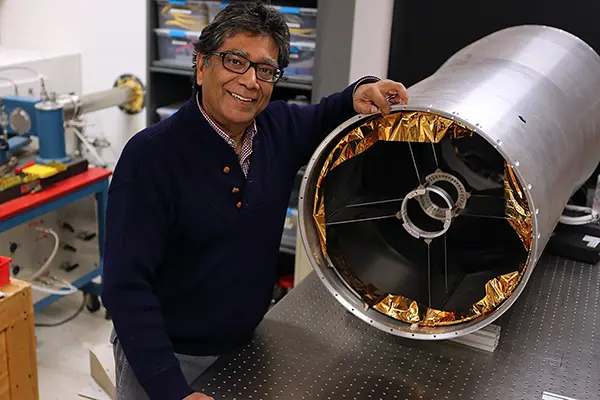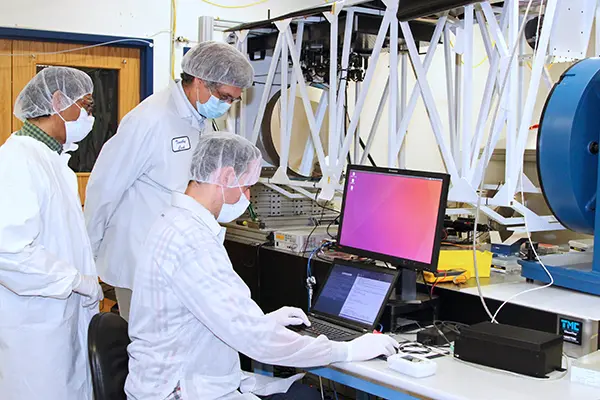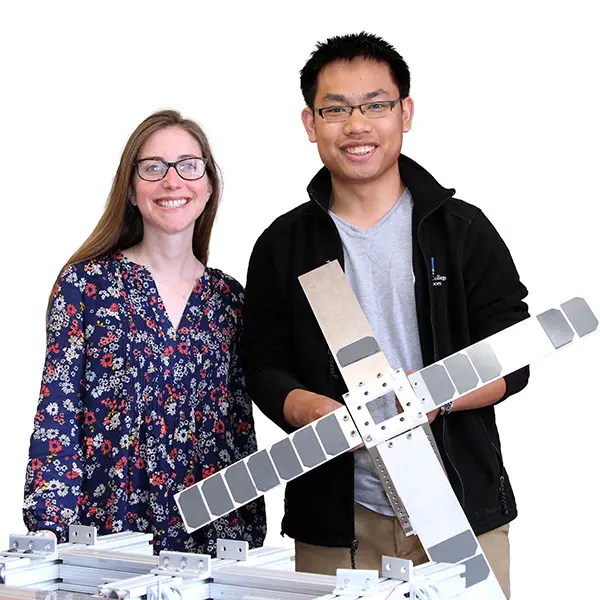UML to Launch Planet-Finding Telescope, Nanosatellite

04/18/2019
By Edwin Aguirre
If all goes according to plan, UMass Lowell will have a planet-finding telescope soaring to the edge of the atmosphere and a miniature satellite orbiting Earth this year. The telescope and satellite are being built and tested at the university’s Lowell Center for Space Science and Technology (LoCSST) by teams of UML students, faculty researchers, scientists and engineers.
“Both missions are firsts for UMass Lowell,” says Prof. Supriya Chakrabarti of the Department of Physics and Applied Physics, who is the principal investigator for both projects. “Our goal is to train the next generation of astronomers, space scientists and engineers through hands-on involvement in all phases of the mission, from instrument development to data analysis.”
The telescope project (dubbed PICTURE-C, which stands for Planetary Imaging Concept Testbed Using a Recoverable Experiment—Coronagraph) aims to develop and validate the technology necessary for detecting Jupiter-size planets orbiting nearby stars in the Milky Way. The project is funded with a five-year, $5.6 million grant from NASA. The team’s ultimate goal is to discover Earth-like planets around sun-like stars capable of supporting life.
“PICTURE-C will enable us to learn about debris disks around other stars and to gain a better understanding of the processes and dynamics that formed our own solar system,” explains Chakrabarti, who directs LoCSST. “But in order for us to do this, we have to fly the instrument to about 120,000 feet — roughly 3½ times higher than the typical cruising altitude of a passenger jetliner — to get above 99 percent of the Earth’s atmosphere. Atmospheric turbulence distorts and blurs our image of the stars.”
 Image by Edwin Aguirre
Image by Edwin Aguirre
TO THE THRESHOLD OF SPACE
“We’re extremely excited,” says LoCSST research scientist Christopher Mendillo. “We’ve done sounding rockets before, but PICTURE-C is our very first balloon mission. Balloons are an amazing platform to use for conducting cutting-edge exoplanet research because of their relatively low cost and long observing duration.”
PICTURE-C features a coronagraph, a specialized optical imaging system coupled to a 24-inch-diameter telescope designed to “mask,” or block out, the direct light from the star so that faint objects very close to the star—such as planets and interplanetary dust, which otherwise would be hidden in the star’s bright glare— can be studied in great detail. High winds in the upper atmosphere are expected to buffet the entire telescope. To keep the coronagraph aimed precisely at the target, the instrument is mounted on a special NASA gimbal platform in the balloon’s gondola that can compensate for any unwanted movements. PICTURE-C will use the platform in conjunction with an onboard active optical pointing control system designed and built by Mendillo and physics Assoc. Prof. Timothy Cook, who is the project’s co-investigator.
“This control system can optically stabilize the light coming out of the telescope and keep the coronagraph centered on the target star to an accuracy of one milliarcsecond, or better,” says Mendillo. “A milliarcsecond is equivalent to resolving an object approximately 2 meters wide on the surface of the moon, which is about 385,000 kilometers away.”
Unlike a sounding rocket, which offers an observing window that lasts only for a few minutes before the payload parachutes back to the ground, the helium balloon will keep PICTURE-C aloft as long as 10 hours. At the end of the mission, ground controllers will send a command to release PICTURE-C from the balloon. A parachute is then deployed to slow PICTURE-C down and allow it to land gently for reuse in the next mission.
Aside from Chakrabarti, Mendillo and Cook, the other members of the PICTURE-C team are LoCSST mechanical engineer Jason Martel and physics graduate students Kuravi Hewawasam and Glenn Howe. Other collaborators include researchers from NASA’s Jet Propulsion Laboratory and Goddard Space Flight Center as well as Caltech, MIT, the Space Telescope Science Institute and the University of California, Santa Barbara.
STUDENT SPACE RESEARCH
In the meantime, a total of about 100 students from physics, math, computer science, mechanical engineering, electrical engineering and computer engineering have worked on the satellite project called SPACE HAUC (pronounced “Space Hawk”), which stands for Science Program Around Communications Engineering with High-Achieving Undergraduate Cadres. The project is funded with a two-year, $200,000 grant from NASA and is based on the CubeSat model used worldwide for Low Earth Orbit space research.
“SPACE HAUC is progressing well,” says Susanna Finn, a research scientist at LoCSST who is advising the team. “Currently, the students are building and testing the CubeSat components, and shortly we will be in our integration and testing phase, assembling the whole system and testing it.”
Once the satellite is flight-ready, the researchers will turn it over to Nanoracks, a Texas-based commercial CubeSat deployer, to prepare it for launch to the International Space Station (ISS), from where it will be released into orbit.
“Launch is currently scheduled in the fall, but these things can still change,” says Finn.
SPACE HAUC will be launched during a scheduled resupply mission to the ISS, either aboard a Northrop Grumman Antares rocket from the Wallops Island spaceport facility in Virginia or a SpaceX Falcon 9 rocket from Cape Canaveral, Florida.
 Image by Edwin Aguirre
Image by Edwin Aguirre
The mission’s goal is to demonstrate the practicality of communicating at high data rates in the X band using a phased array of patch antennas on the CubeSat and electronic beam steering. The antennas will operate at frequencies of 7.2 to 8.3 gigahertz from an orbit of about 450 kilometers.
“The use of X-band signal has yet to be attempted in a CubeSat and, if successful, would aid future CubeSat applications and space exploration,” says Simthyrearch Dy, SPACE HAUC’s student program manager. Dy is an Honors College student and a computer science, physics and math triple major from Lowell.
“Many CubeSats transmit data to ground controllers in the S-band at an average speed of 2 to 5 megabits per second. SPACE HAUC seeks to increase the speed to 50 to 100 megabits per second,” he says.
The students plan to maintain a communication link between the satellite and ground stations at the university’s Olney Science Center on North Campus and the MIT Haystack Observatory in Westford, Mass. SPACE HAUC is expected to stay in orbit for about a year or more before it gradually loses altitude and falls back to Earth, disintegrating and burning up harmlessly high above the ground.
Finn says the students’ drive and dedication have impressed her from day one: “They have been very independent and self-motivated to dive right in and research and learn what they need to know.”
For some, the project has opened the door to new career possibilities.
“This experience has laid the groundwork for my eventual plan of working for NASA,” says Dy. “I have background knowledge from my studies in STEM, and now I have R&D experience in an actual space science mission. An opportunity like this doesn’t come around often, especially during one’s undergraduate years.”
He adds, “The Francis College of Engineering has recently started offering a minor in aerospace studies. Because of SPACE HAUC, I plan to pursue a Ph.D. in either astronomy or computer science.”
In addition to LoCSST, other SPACE HAUC research collaborators include the university’s Raytheon-UMass Lowell Research Institute and the Printed Electronics Research Collaborative, as well as the Massachusetts Space Grant Consortium, Raytheon, BAE Systems and Draper Laboratory.
